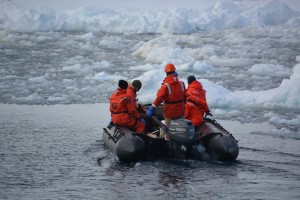Increased melting of Antarctic glaciers in the coming decades, which scientists say could occur as a result of climate change, could cause a spike in the amount of iron in the polynyas, according to the new study. The increased iron could boost phytoplankton in these open areas, potentially providing more food for the entire food chain, suggests the new study accepted for publication in Journal of Geophysical Research: Oceans, an American Geophysical Union journal.
“These coastal polynyas are sensitive to inputs from adjacent glaciers, and these glaciers are probably going to accelerate their melting in the future, which is certainly going to have implications for these polynyas,” said Kevin Arrigo, a biological oceanographer with the Department of Earth System Science at Stanford University in California, and lead author of the new study.
“Coastal Antarctica is likely to become a more productive place in the future,” Arrigo said.
Scientists and ASC Marine Technicians head out on the zodiac to collect ice samples near the West Antarctic Peninsula. Pictured from left to right: Kevin Arrigo (Stanford), John Betz (ASC Marine Lab), Tom Sigmond (ASC Marine Lab), Yussi Delgado (Monash Univeristy), John Butterfield (Stanford).
Credit: Hannah Joy-Warren
Polynyas are created during the summer when winds whip off the Antarctic Ice Sheet, pushing floating sea ice away from the shore. These open areas of water, which range from the size of San Diego to an area equal to the Great Lakes, are hot spots for phytoplankton and, in turn, the entire ocean food chain, according to Arrigo.
“When you look at satellite images of ocean color, these areas just light up [green] compared to the [blue] waters around them,” he said.
The new research by Arrigo and his team suggests that the amount of water leaving melting Antarctic glaciers is the largest driver behind the abundance of phytoplankton in the polynyas, not sunlight or temperature as scientists had previously thought. Larger amounts of water coming off the glaciers carry more iron into the polynyas, which should simulate more phytoplankton growth, according to the new study.
This new information about phytoplankton growth in polynyas, based on satellite data, gives scientists greater insight into how the Antarctic marine food web works and how it could be affected by climate change, according to the study’s authors. Arrigo noted that although climate change could increase the amount of iron in the polynyas, any positive effects of the additional iron may be offset by other climate change-driven environmental shifts. He added that most marine organisms will be negatively affected by global increases in ocean temperatures and acidification that are expected to happen as a result of climate change.
The new research could also shed light on how carbon is stored in the ocean, Arrigo said. The new study suggests that phytoplankton in the polynyas could be responsible for pulling in large amounts of carbon dioxide from the atmosphere through photosynthesis. The polynyas could be acting as storage sites for carbon released into the atmosphere by fossil fuel burning, according to the new study.
“These polynyas appear to be disproportionately important, for their size, as sinks of carbon. And the reality is that they really are not included in anyone’s carbon budget,” said Arrigo.


